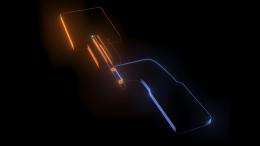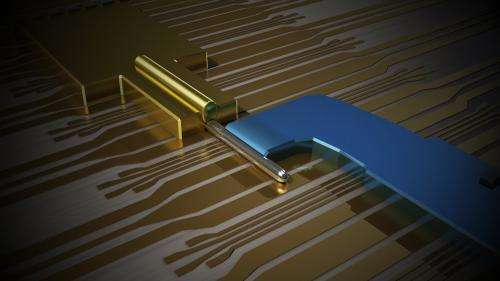April 13, 2012 report
Researchers find possible evidence of Majorana fermions

(Phys.org) -- Researchers working out of Delft University of Technology in the Netherlands have constructed a device that appears to offer some evidence of the existence of Majorana fermions; the elusive particles that are thought to be their own antiparticles. The team, as they describe in their paper published in Science, created a device with a topological superconductor that was also able to measure the relationship between current and voltage at significant points on a nanowire which when in the presence of a magnetic field or electrical current, indicated the existence of Majorana fermions.
Majorana fermions are electrically neutral elementary particles of matter first theorized by Ettore Majorana in 1937. Unlike other particles such as electrons which correspond with their antimatter counterparts positrons, Majorana fermions have no antimatter mate, they serve as their own antiparticles, and because of that, researchers believe they might one day be useful in creating quantum computers, because when moved, they are believed to have a property that allows them to remember their former position.

To try to show that Majorana fermions can be observed, the team built a device that employed the use of a topological superconductor, which is a material that has an inner part that has zero electrical resistance while the outer part is a normal conductor. Prior to this experiment, theorists had predicted that such a material would have Majorana fermions in it.
To create a device that would have both the right material and a means of measuring Majorana fermions, the team connected an indium antimonide nanowire in between an electrode made of gold and the end of a superconducting material. They then placed the result onto a silicon substrate which had been preprinted with logic circuits to allow for reading the electronic properties of the nanowire. With the stage set, the team then cooled the device to just fractions of degrees above absolute zero and then introduced a magnetic field at one point and additional current at another. In both instances, the researchers found that at two points along the wire, their device registered a strong response at just the places where Majorana fermions were predicted to occur. The responses in effect showed that the particles didn’t move when in the presence of a magnetic field or an electric current, because they are electrically neutral.
In contrast, when any of the elements in the device were changed, the responses did not occur, showing that the device they had built did indeed match the theory behind it.
This experiment doesn’t exactly show the existence of Majorana fermions, as the researchers readily acknowledge, but it does offer strong evidence that not only do they exist, but that their properties can be demonstrated, which is a major step forward in the study of particle physics.
More information: Signatures of Majorana Fermions in Hybrid Superconductor-Semiconductor Nanowire Devices, Science, DOI: 10.1126/science.1222360
ABSTRACT
Majorana fermions are particles identical to their own antiparticles. They have been theoretically predicted to exist in topological superconductors. We report electrical measurements on InSb nanowires contacted with one normal (Au) and one superconducting electrode (NbTiN). Gate voltages vary electron density and define a tunnel barrier between normal and superconducting contacts. In the presence of magnetic fields of order 100 mT, we observe bound, mid-gap states at zero bias voltage. These bound states remain fixed to zero bias even when magnetic fields and gate voltages are changed over considerable ranges. Our observations support the hypothesis of Majorana fermions in nanowires coupled to superconductors.
Journal information: Science
© 2012 Phys.Org


















